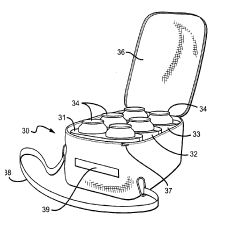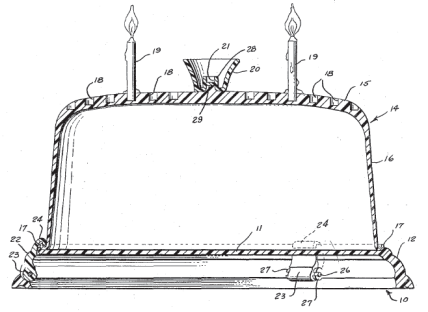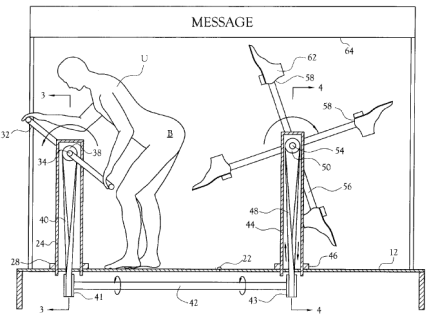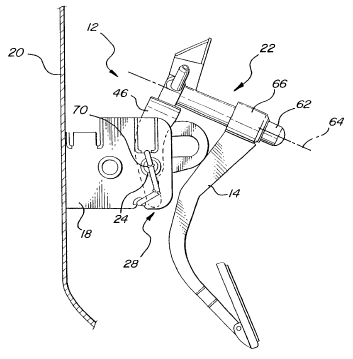Beer-Powered Fuel Cells.

If you have a few spare minutes, check out this article on the development of fuel cells powered by the byproducts of beer production, titled: A Cleaner Environment . . . Through Beer.
Ahhh, sometimes you just have to love the advancement of science and the useful arts.
Happy Birthday AT! (1-Year).

Well, we have managed to survive our first year in the IP blogosphere. Although we recognize that we don’t take ourselves as seriously as some of the other patent law blogs out there, we hope you, our faithful readers, continue to enjoy our unique mix of content! Here’s to another successful year!
Google Patent Search, Does No Evil? (Update)
At our previous post on the Google Patent Search tool, Google Patent Search, Does No Evil?, we had lamented the fact that the search tool did not provide a function allowing users to download a pdf copy of a patent located via the search tool. Well, we lament no more.
Another quick look at the service has revealed that Google recently upgraded the system to provide a “Download PDF” option. Even more impressive, the downloads appear to be available for pre-1976 patents (based on our rudimentary search for U.S. Pat. Nos. 500,000 and 1,000,000), thus providing a tool that both key-word searches pre-1976 patents and faciliates an easy download of said patents.
For advanced searches using the Google service, go to: http://www.google.com/advanced_patent_search.
They Invented What? (No. 47)
U.S. Pat. No. 6,872,145: Solo-operable seesaw.
JW Note: Per David McClaughry at HD&P, this invention “takes all the fun out of the teeter-totter.” Enjoy.

What is claimed as new and what is desired to secure by Letters Patent of the United States is:
1. A seesaw movable between ground and elevated positions and comprising: a base member having oppositely spaced side sections and a back section integral therewith and spaced therebetween, said side sections having respective bottom edge portions for engaging a ground surface and further having respective top edge portions for defining an apex of said base member, said base member further including a plurality of elongated braces having opposed end portions connected thereto and for maintaining said side sections at substantially stable positions; an elongated plank having a first end portion engaged with said base member and being selectively pivotable thereabout, said plank further having an oppositely spaced second end portion defining a seat for receiving an operator thereon; and means for pivotally lifting said plank upwardly along a predetermined arcuate path after said second end portion of said plank is moved to select lowered positions, said lifting means being connected to said base member and said plank respectively.
They Invented What? (No. 46)
U.S. Pat. No. 6,293,874: User-operated amusement apparatus for kicking the user’s buttocks.
JW Note: Many thanks to David McClaughry at HD&P for bringing this one to our attention.

Having thus described the aforementioned invention, I claim:
1. An amusement apparatus operated and controlled by a user, comprising:
a platform having a first end and a second end;
first post and second posts detachably mounted on said platform, said first post positioned toward said first end and said second post positioned toward said second end of said platform at a distance from said first post sufficient to permit the user to locate therebetween, facing said first post;
said first post having a crank positioned at a height thereon which requires the user to bend forward toward said first post while grasping said crank with both hands, to prominently present his buttocks toward said second post;
said second post including a top end having a plurality of rotating arms detachably mounted thereon, said plurality of rotating arms having a central axis positioned at a height generally level with the user’s buttocks;
an outboard end on each of said plurality of rotating arms; and
a drive train operatively interconnecting between said crank and said central axis of said plurality of rotating arms;
whereby as the user bends forward while grasping said crank, the user bends at his waist to predominantly present his buttocks toward said outboard end on each of said plurality of rotating arms, and the user operates said crank to engage said drive train and to rotate said plurality of rotating arms, causing each respective outboard end on each of said plurality of rotating arms to sequentially strike the user’s buttocks.
(more…)
USPTO’s KSR Memo on Section 103 Rejections.
As reported at a number of sources, Margaret Focarino, Deputy Commissioner for Patent Operations, has issued the following memo to the Technology Center Directors regarding the KSR opinion and the effect of the opinion on USPTO obviousness rejections: KSR Memo.
If you’re a practitioner, worth a quick read. The most important section being below, in our opinion.

They Invented What? (No. 45)
U.S. Pat. No. 6,237,565: Adjustable pedal assembly with electronic throttle control.
JW Note: In honor of the KSR v. Teleflex opinion issued this week . . . actually, isn’t “TIW?” what the Supreme Court said?

What is claimed is:
1. An adjustable pedal assembly for a vehicle comprising;
a support (18) for mounting to a vehicle structure;
an adjustable pedal assembly (22) having a guide member (62) rotatably supported by said support (18) for pivotal movement about a pivot axis (26); and
a pedal arm (14) supported on said guide member (62) for rectilinear movement in fore and aft directions relative to said support (18), said guide member (62) and said pivot axis (26) between various adjusted positions;
an electronic control (28) supported on said support (18) and responsive to pivotal movement of said pedal arm (14) and said guide member (62) about said pivot axis (26),
said electronic control (28) being fixed relative to said support (18) such that said pedal arm (14) moves in fore and aft directions with respect to said electronic control (28), said electronic control (28) being responsive to pivotal movement of said guide member (62) about said pivot axis (26) for providing a signal (32) that corresponds to pedal arm (14) position as said pedal arm (14) pivots said guide member (62) about said pivot axis (26).
2. An assembly as set forth in claim 1 wherein said pedal arm (14) is in sliding engagement with said guide member (62) and extends from said guide member (62) to lower pad end.
3. An assembly as set forth in claim 2 including a drive for moving said pedal arm (14) along said guide member (62).
4. A vehicle control pedal apparatus (12) comprising:
a support (18) adapted to be mounted to a vehicle structure (20);
an adjustable pedal assembly (22) having a pedal arm (14) moveable in force and aft directions with respect to said support (18);
a pivot (24) for pivotally supporting said adjustable pedal assembly (22) with respect to said support (18) and defining a pivot axis (26); and
an electronic control (28) attached to said support (18) for controlling a vehicle system;
said apparatus (12) characterized by said electronic control (28) being responsive to said pivot (24) for providing a signal (32) that corresponds to pedal arm position as said pedal arm (14) pivots about said pivot axis (26) between rest and applied positions wherein the position of said pivot (24) remains constant while said pedal arm (14) moves in fore and aft directions with respect to said pivot (24).
Microsoft Corp. v. AT&T Corp.
Title 35 U.S.C. § 271(f)(1) does not govern the manufacture and sale of components of U.S. patented inventions in foreign countries.
Title 35 U.S.C. § 271(f)(1) provides that it is an act of direct patent infringement to “suppl[y]. . . from the United States . . . components of a patented invention . . . in such manner as to actively induce the combination of such components outside of the United States.”
In this case, AT&T Corp. alleged that when Microsoft Corporation’s Windows software was installed on a personal computer outside tbe U.S., the programmed computer infringed AT&T’s patent for a “Digital Speech Coder” system. AT&T sought damages not only for each Windows-based computer made or sold in the United States, but also, under Section 271(f)(1), for each computer made and sold abroad. Extending Section 271(f)—and consequently, the extraterritorial application of U.S. patent law—the Federal Circuit held that Microsoft infringed under Section 271(f)(1) when it exported master versions of its Windows software code to foreign computer manufacturers, who then copied the software code and installed the duplicate versions on foreign-manufactured computers that were sold only to foreign consumers. The Supreme Court reversed.
In reversing the holding of the CAFC, the Supreme Court stated:
Because Microsoft does not export from the United States the copies of Windows installed on the foreign-made computers in question, Microsoft does not “suppl[y] . . . from the United States” “components” of those computers, and therefore is not liable under §271(f)as currently written. . . .
Foreign conduct is generally the domain of foreign law, and in the patent area, that law may embody different policy judgments about the relative rights of inventors, competitors, and the public. Applied here, the presumption tugs strongly against construing §271(f) to encompass as a “component” not only a physical copy of software, but also software’s intangible code, and to render “supplie[d] . . . from the United States” not only exported copies of software, but also duplicates made abroad. Foreign law alone, not United States law, currently governs the manufacture and sale of components of patented inventions in foreign countries. If AT&T desires to prevent copying abroad, its remedy lies in obtaining and enforcing foreign patents. . . .
REVERSED.


leave a comment